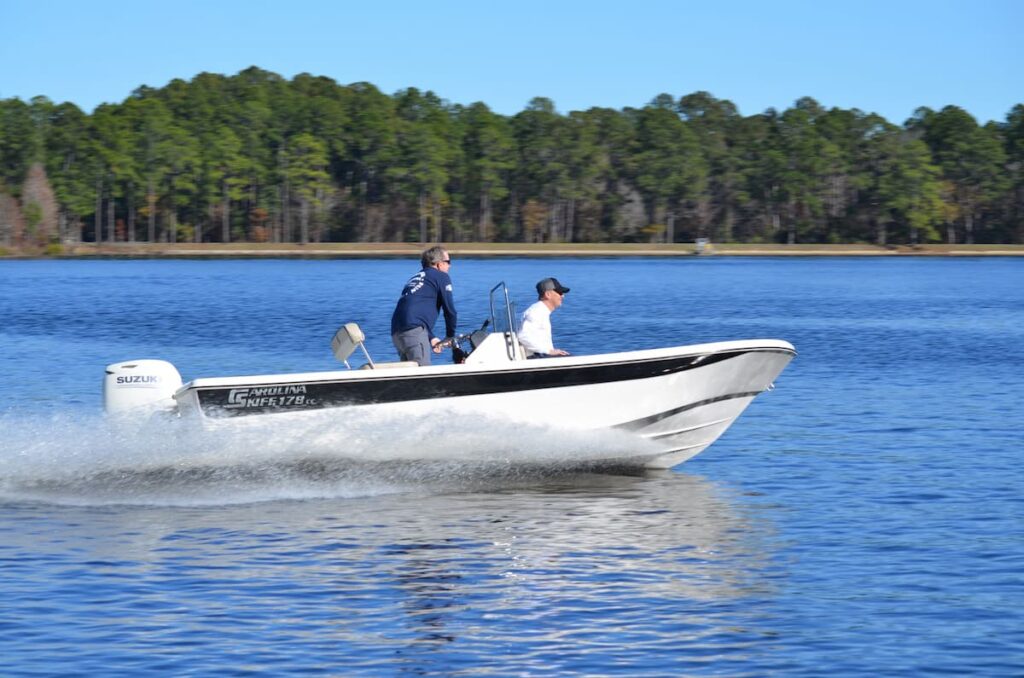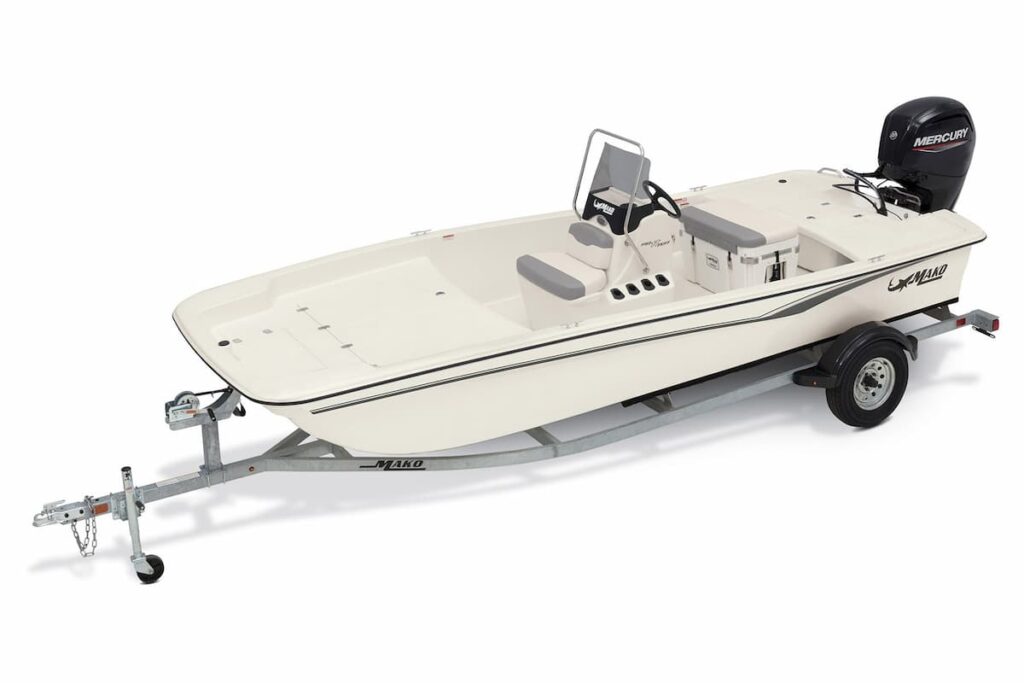A skiff boat is a type of small boat that is designed for use in shallow water. Although the term “skiff” can be used to describe many different types of small boats, it typically refers to a simple, open-design boat that has a few basic features. Skiffs are often used for fishing or recreational boating, and they are popular among boaters who enjoy exploring shallow waters.
Skiff boats are typically small and lightweight, which makes them easy to maneuver in tight spaces. They are often powered by an outboard motor, and they typically have a simple hull design that allows them to navigate shallow waters with ease. Skiffs are often used for fishing because they are able to access areas that larger boats cannot reach.

Skiff boats come in many different shapes and sizes, and they can be made from a variety of materials. Some skiffs are made from wood, while others are made from fiberglass or aluminum. Skiffs can be customized with a variety of features, such as fishing rod holders, livewells, and storage compartments. Whether you are an avid fisherman or a recreational boater, a skiff boat can be a great choice for exploring shallow waters and enjoying the great outdoors.
What is a Skiff Boat?
A skiff boat is a small, open boat that is commonly used for fishing in shallow waters. It is a type of fishing boat that is often characterized by its simple design and lack of complex electrical or plumbing systems. Skiffs are typically made up of a hull, outboard engine, some seats, and a few fishing rod holders.
Origin of the Definition
Skiffs are a type of small boat that can be used to describe many different types of boats. Generally, skiffs are small, open boats that are designed for use in shallow waters. They are typically simple in design, with no complex electrical or plumbing systems. Skiffs are usually made up of a hull, outboard engine, some seats, and a few fishing rod holders. They are often used for fishing, crabbing, clamming, or just puttering around small bays and tributaries.
History
The history of skiff boats is a long and storied one. Skiffs have been used for centuries for fishing and transportation in shallow waters. The design of the skiff has evolved over time, with new materials and technologies being used to create more efficient and effective boats. Today, skiffs are typically made from materials such as aluminum, fiberglass, wood, Kevlar, or carbon fiber. Some popular skiff boat brands include Carolina Skiff, Sundance, and Spyder.
Flats skiffs and technical poling skiffs are two popular types of skiffs that are designed specifically for fishing in shallow saltwater flats. Flats skiffs are typically designed with a v-hull and a livewell, while technical poling skiffs are designed with a flat bottom and a raised platform for the angler to stand on while poling the boat through shallow water.
Overall, skiff boats are a versatile and popular type of small boat that can be used for a variety of activities. Whether you are fishing, crabbing, or just exploring the local waterways, a skiff boat is a great choice for anyone who loves boating.
Types of Skiff Boats
Skiff boats are small, open-design boats that are popular among anglers and boaters who enjoy exploring shallow waters. They are simple in design and function, making them easy to use and maintain. There are several major designs or use variations to consider when it comes to skiff boats, including:
Flat Bottom Skiffs
Flat bottom skiffs are one of the most common types of skiff boats. They are typically made of aluminum or fiberglass and are designed for use in shallow waters. Flat bottom skiffs are perfect for anglers who like to fish in calm, shallow waters, such as bays, estuaries, and flats. They are also great for exploring rivers and creeks.

The Pro Skiff 17 CC is a great example of the skiff. This model is made entirely of composite materials and is MAKO top-selling model as it offers exceptional fishing capabilities in a compact and agile package. Its innovative Advanced Inverted V (AIV) hull design ensures rapid acceleration, a smooth and dry ride, as well as impressive handling and maneuverability. Perfect for various inshore fishing activities, this boat boasts a nearly 3/4-ton capacity, making it one of the most industrious vessels in its category.
V-Hull Skiffs
V-hull skiffs are another popular type of skiff boat. They are designed with a V-shaped hull, which allows them to cut through choppy water more easily than flat bottom skiffs. V-hull skiffs are typically made of fiberglass and are ideal for use in saltwater environments. They are also great for anglers who like to fish in deeper waters.
Technical Poling Skiffs
Technical poling skiffs are designed for use in extremely shallow waters. They are typically made of high-tech materials such as Kevlar or carbon fiber, which makes them lightweight and easy to maneuver. Technical poling skiffs are perfect for anglers who like to fish in flats and other shallow areas. They are also great for those who enjoy sight fishing.
Some skiffs come pre-outfitted with fishing accessories and features like rod racks or live wells. Others are more basic in design and require the addition of aftermarket accessories to make them suitable for fishing. Skiffs can be made of a variety of materials, including wood, aluminum, and fiberglass. Popular brands of skiff boats include Carolina Skiff, Sundance, and Spyder.
Features of Skiff Boats
Size and Weight
Skiff boats are small and lightweight vessels that are perfect for fishing in shallow waters. They range in size from 17-25 feet and weigh around 1,500 pounds. Due to their lightweight, they do not need a powerful motor and can save a lot of fuel compared to other larger boats.
Draft and Beam
Skiffs have a shallow draft, which means they can access shallow waters that other boats cannot. They also have a narrow beam, which makes them more maneuverable and easier to handle.
Materials
Skiffs are made of different materials, including aluminum, fiberglass, wood, Kevlar, and carbon fiber. Aluminum skiffs are lightweight and durable, easy to paint, making them perfect for saltwater fishing. Fiberglass skiffs are more expensive but are more durable and require less maintenance.
Accessories
Skiffs come with a few accessories, including fishing rod holders, livewells, and other fishing accessories. Some skiffs are designed for technical poling, which means they have a flat bottom and a V-hull to help navigate in shallow waters.
Overall, skiffs are simple, open-design boats that are perfect for fishing in shallow waters. They are lightweight, easy to handle, and require minimal maintenance. Whether you are a novice or an experienced angler, a skiff boat can be a great investment for your boating and fishing needs.
Advantages of Skiff Boats
Skiff boats are a popular choice for boaters looking for a simple and versatile vessel. They come in various sizes and designs, from open boats to flats skiffs, and are often used for fishing, saltwater exploration, and leisurely cruising. Here are some advantages of skiff boats:
Stability
One of the main advantages of skiff boats is their stability. Skiffs have a flat bottom, which provides excellent stability in calm waters and shallow areas. This makes them ideal for fishing and technical poling, where stability is crucial for casting and standing. Some skiffs also have a V-hull design, which offers better stability in choppy waters and rough conditions.
Maneuverability
Skiff boats are known for their maneuverability, thanks to their lightweight and streamlined design. They are easy to handle and can navigate through narrow channels, shallow waters, and tight spaces. Skiffs also have a low draft, which allows them to access areas that larger boats cannot reach. This makes them perfect for exploring hidden coves, flats, and marshes.
Fuel Economy
Another advantage of skiff boats is their fuel economy. Skiffs are lightweight and require less power to move, which means they consume less fuel than larger boats. This makes them more affordable to operate and maintain in the long run. Skiffs also have a smaller carbon footprint, which is better for the environment.
In conclusion, skiff boats offer several advantages over larger vessels, including stability, maneuverability, and fuel economy. They are a great choice for boaters looking for a simple and versatile vessel that can handle a variety of activities, from fishing to leisurely cruising. Whether you prefer aluminum, fiberglass, wood, Kevlar, or carbon fiber, there is a skiff boat out there that will suit your needs and budget.
Uses of Skiff Boats
Skiff boats have many uses, including fishing, boating and cruising, and water sports. They are small, open boats that are typically used in saltwater environments. Skiffs are simple in design and construction, with no complex electrical or plumbing systems. They are made up of a hull, outboard engine, some seats, and a few fishing rod holders. Below are the most common uses of skiff boats:
Fishing
Skiff boats are commonly used for fishing in shallow waters. They are ideal for this purpose because they are small and maneuverable, allowing anglers to get into tight spaces where larger boats cannot go. Skiffs are also equipped with livewells and other fishing accessories that make them perfect for catching fish. Skiffs can be used for a variety of fishing styles, including fly fishing, baitcasting, and trolling.
Boating and Cruising
Skiff boats are also used for boating and cruising. They are perfect for exploring shallow waterways and canals, and they are ideal for day trips and picnics. Skiffs are easy to operate and maintain, making them a popular choice for recreational boaters. They are also affordable and fuel-efficient, which makes them a great option for budget-conscious boaters.
Water Sports
Skiff boats are also used for water sports, such as water skiing, wakeboarding, and tubing. They are equipped with powerful outboard engines that can pull skiers and wakeboarders at high speeds. Skiffs are also stable and maneuverable, which makes them a great choice for these types of activities.
- Types of Gas Carriers as per IGC Code – April 22, 2025
- Wind-Assisted Propulsion Systems (WAPS): A Game Changer for Maritime Decarbonization – February 6, 2025
- 10 Boat Salvage Yards in California – January 25, 2025



